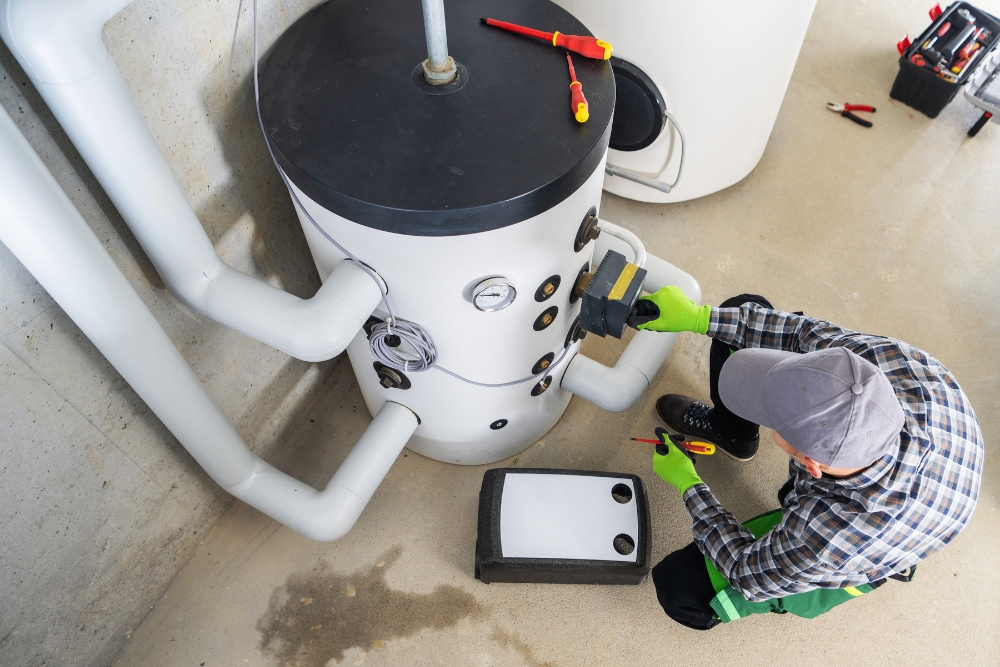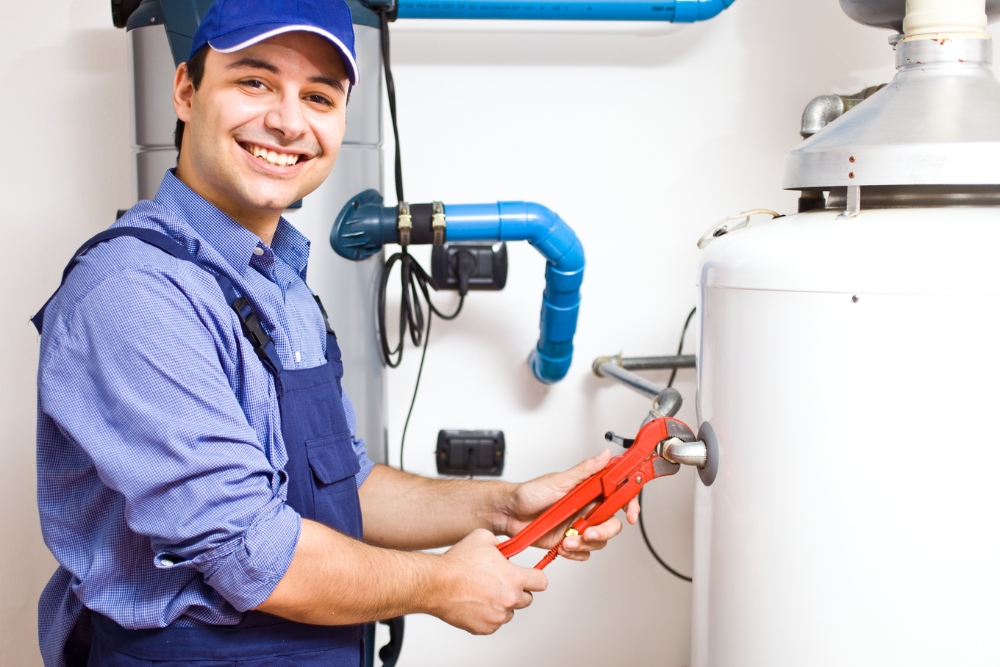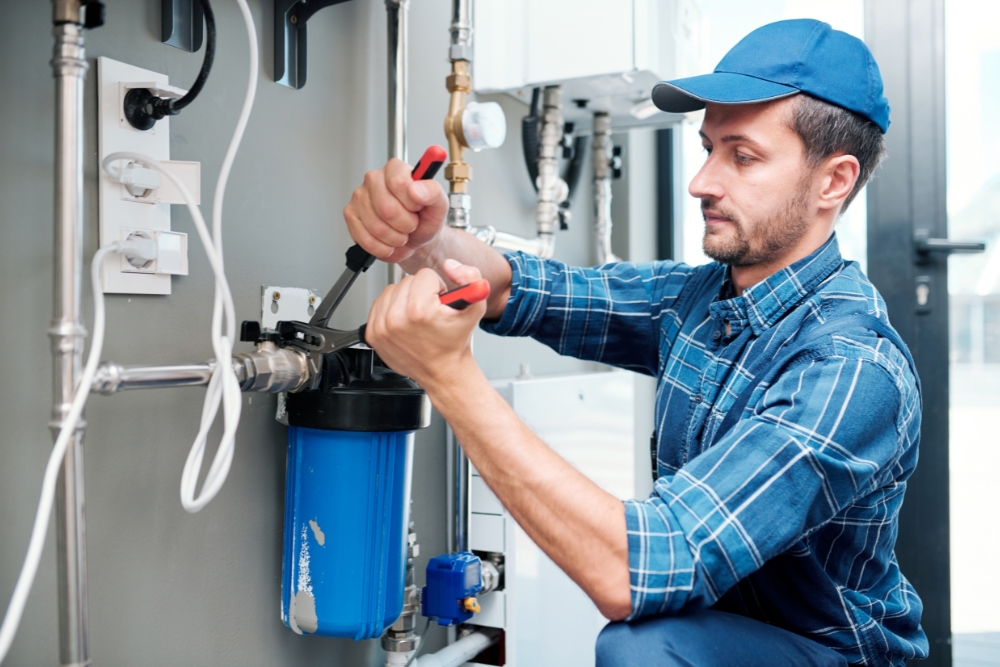Ever found yourself in the middle of a chilly morning, turning on the tap only to be greeted by lukewarm water instead of the steaming hot shower you were looking forward to? You’re not alone there! We’ve also scratched our heads over why it’s suddenly taking an eternity for the water to heat up, not to mention those odd popping noises coming from the system.
Turns out, sediment buildup is often the sneaky troublemaker behind these nuisances. But worry not—we’ve dug deep into how you can sort this issue out yourself. This blog’s packed with handy tips that’ll get your hot water system back in top shape before you know it.
Key Takeaways
- To prevent sediment buildup in your hot water system, flush it out twice a year. This keeps the water flowing efficiently and stops minerals from settling at the bottom of the tank.
- Using white vinegar can break down mineral deposits inside your hot water tank. Pour one to two gallons into the tank and let it sit for at least 24 hours before flushing it out.
- Installing a water softener helps combat hard water, which is a common cause of sediment accumulation in hot water systems. Softened water reduces mineral buildup, enhancing your system’s effectiveness and lifespan.
- Regular checks on thermostat settings and pressure valves are vital. They help maintain the correct temperature and pressure, preventing issues like low hot water supply or leaks.
- If DIY fixes don’t solve your hot water problems, hiring professional services might be necessary. Experts can offer thorough diagnostics and solutions that save energy and extend your system’s durability.

Understanding Sediment Buildup in Hot Water Service Systems
Sediment buildup in hot water service systems occurs when minerals and other particles settle at the bottom of the tank, restricting water flow. This buildup can lead to decreased efficiency, shorter equipment lifespan, and increased energy consumption.
What is sediment buildup
Sediment buildup in our hot water systems refers to the accumulation of minerals like calcium and magnesium, common in hard water. These particles settle at the bottom of our water heaters over time, creating a layer that can affect the system’s performance.
This process not only leads to a decrease in water quality but also increases energy costs as our heaters work harder to heat the same amount of water. Regular flushing and descaling can prevent this issue, ensuring our systems run efficiently.
These mineral deposits can lead to issues including popping sounds from the tank, fluctuating temperatures, and even murky or rust-coloured water flowing from our taps. In severe cases, sediment buildup displaces water in the tank, clogs up drain valves, blocks lines, or causes premature failure of the entire system.
Understanding how it affects your hot water system is crucial for maintaining an efficient home heating setup.
How it can affect your hot water system
Sediment buildup in your hot water system can lead to reduced efficiency and increased energy costs. This buildup can displace water in the tank, clog up the drain valve, block water lines, or even cause premature tank failure.
Signs of sediment accumulation include popping sounds, fluctuating water temperature, and cloudy or rust-colored water. To avoid these issues, regular maintenance and troubleshooting are essential to ensure efficient operation.
Maintaining your hot water system is crucial for preventing sediment buildup and ensuring a consistent supply of hot water throughout your home. By regularly checking the thermostat settings, pressure valve, and promptly replacing any damaged parts as needed, you can address potential issues before they impact the performance of your hot water system.
Additionally, flushing the unit twice a year by completely draining it can help prevent sediment buildup and maintain its efficiency over time.
Cleaning Sediment from Your Hot Water System
To clean sediment from your hot water system, take safety precautions and prepare for the task. After draining the tank, remove the sediment from the bottom and flush out any remaining particles to ensure efficient water flow.
Preparation and safety precautions
Before cleaning sediment from your hot water system, it’s important to turn off the power supply and allow the tank to cool down. This prevents any potential accidents or burns during the cleaning process.
Additionally, make sure to wear protective gloves and eyewear when handling sediment removal chemicals or tools to prevent skin irritation or eye injuries.
To ensure safety, always check for gas leaks before proceeding with any maintenance on a gas hot water system. If you detect a gas leak odor near the unit, immediately turn off the gas supply and contact a professional plumber for assistance.
Lastly, be cautious when draining the tank as the water may still be scalding hot – use appropriate tools and follow manufacturer guidelines for safe drainage procedures.
By following these preparation and safety precautions, homeowners can effectively clean sediment from their hot water systems while reducing the risk of accidents or damage to their units.
Draining the tank
To drain the tank, turn off the power supply or gas to the water heater. Next, hook up a garden hose to the drain valve located at the bottom of the tank and direct it to an appropriate draining location.
Open a nearby hot water tap to allow air into the system while draining. Then, open the drain valve completely and let all of the water flow out until it runs clear. After that, close both valves (drain and tap) once all water has been drained.
Use caution as you handle this process for safety reasons – hot water can cause burns. Ensure you’ve properly prepared for this maintenance procedure and follow any specific manufacturer’s guidelines for your unit before beginning work on your hot water service system.
Removing sediment from the tank
We remove sediment from the tank by turning off the water heater and letting it cool. Then, attach a garden hose to the drain valve at the base of the tank. Open a hot water faucet in your house to relieve pressure within the system before draining begins.
After that, carefully open the drain valve and let all of the water flow into a nearby floor drain or outside.
Dispose of any collected sediment and ensure that there is no remaining debris inside before closing and tightening all openings on your hot water system. Refill your tank with fresh cold water until it vents completely through an open tap without air bubbles.
Flushing Your Unit
After removing sediment from the tank, it’s essential to flush your hot water unit. Flushing your unit twice a year will help prevent sediment buildup and maintain the efficiency of your hot water system.
To do this, turn off the power supply or gas valve and connect a garden hose to the drain valve at the base of the heater. Open a hot water tap in your house to allow air into the system while draining and then open the drain valve.
Let all of the water drain out before closing the drain valve and refilling the tank.
Maintaining your hot water system through regular flushing can significantly extend its lifespan and ensure consistent performance, saving you money on energy costs while providing ample hot water for your household needs.
Vinegar Soak
To remove sediment buildup in your hot water system, consider using a vinegar soak. This simple and natural solution can help break down the mineral deposits inside the tank. Start by turning off the gas or electricity to the heater and let it cool for a few hours.
Once cooled, use a funnel to pour one to two gallons of white vinegar into the tank, ensuring that it covers all exposed areas. Let the vinegar sit undisturbed for at least 24 hours to dissolve any remaining sediment.
Afterward, carefully drain and flush out the tank before turning on the water supply and restoring power.

Maintain Temperature
To maintain temperature in your hot water system, it’s essential to regularly check the thermostat settings. Keep an eye on the temperature dial and ensure it’s set to a comfortable level for your household needs.
Additionally, make sure to monitor the pressure valve, as any issues with this component can affect the overall temperature of your water. By keeping a close watch on these factors, you can help prevent sudden fluctuations in water temperature and maintain a consistent supply of hot water for your home.
Moving forward to “Water Softener Installation,” let’s explore how installing a water softener can further support efficient function of your hot water service system.
Water Softener Installation
Maintaining temperature in your hot water system is crucial, and installing a water softener can further improve its efficiency. Hard water can lead to mineral buildup inside the water heater, reducing its effectiveness and potentially causing damage.
By installing a water softener, you can prevent mineral deposits from forming in your hot water system, ensuring that it operates at peak performance for longer periods of time. This simple installation step could save you money on energy costs and help extend the lifespan of your hot water service system.
Regular maintenance like this goes a long way in preventing sediment buildup and ensuring efficient operation.
Troubleshooting Common Problems with Hot Water Systems
If your hot water system is malfunctioning, our troubleshooting guide can help you identify and fix common issues. Explore solutions for no hot water, insufficient hot water, leaks, low water pressure, slow heating water and more.
No hot water in the house
If you’re experiencing no hot water in your house, it could be due to sediment buildup in your hot water system. Sediment can accumulate at the bottom of the tank over time, insulating the water from the heating element and preventing it from reaching the desired temperature.
This issue may also arise if there’s a faulty heating element, thermostat malfunction, or gas supply interruption. To address this problem, consider checking the thermostat settings and pressure valve for any issues.
If these components are functioning properly yet you still have no hot water, consult a professional for further assessment.
Regular maintenance of your hot water system can help prevent sediment buildup and ensure efficient operation. Flushing your unit twice a year can minimise sediment accumulation and extend the lifespan of your water heater.
Not enough hot water
If you’re experiencing not enough hot water, it could be due to sediment buildup in your hot water system. Sediment can displace the volume of water in the tank and reduce its capacity to heat and store hot water.
Check for signs such as popping sounds and fluctuating temperature, which may indicate sediment accumulation impacting your system’s ability to provide an adequate supply of hot water.
Flushing the unit regularly, checking thermostat settings, and maintaining pressure valves are effective ways to prevent sediment buildup issues and ensure consistent hot water availability.
Tank or plumbing leaks
Check for any visible signs of tank or plumbing leaks, such as water pooling around the base of the unit or damp spots on walls and floors. Addressing these issues promptly is crucial to prevent water damage and potential structural issues in your home.
Remember that even small drips can indicate a larger problem, so it’s essential to seek professional assistance if you notice any signs of leakage.
Regularly inspect the pressure relief valve and drain valve for leaks or corrosion. Keep in mind that fixing these minor leaks can help prolong the lifespan of your hot water system and prevent significant water damage to your property over time.
Low water pressure
If you’re experiencing low water pressure in your hot water system, it could be due to sediment buildup or mineral deposits clogging the pipes and fixtures. Sediment accumulation in the lines leading up to your hot water service can restrict the flow of hot water, ultimately resulting in reduced pressure at your taps and showers.
Addressing this issue promptly is crucial to maintain a consistent and efficient supply of hot water throughout your home.
Regular maintenance and flushing of your hot water service can help prevent sediment buildup within the system, ensuring optimal performance. Additionally, installing a water softener can reduce mineral deposits within the plumbing, aiding in maintaining adequate pressure for consistent hot water supply.
Slow heating water
If your hot water takes longer to heat up than usual, it could be due to sediment buildup in the tank. Sediment can insulate the water from the heating element, causing slow heating.
Flushing the water heater twice a year helps prevent sediment buildup and ensures efficient operation. Additionally, checking the temperature settings and maintaining proper thermostat levels can also help address slow heating issues in your hot water system.
Regular maintenance is crucial for preventing sediment buildup and keeping your hot water unit functioning effectively. Inconsistent water temperatures may indicate issues such as faulty components or mineral deposits inside the heater.

How to Fix Hot Water System Issues
To fix hot water system issues, you can either seek professional repair services or explore various DIY repairs. Click to read more about maintaining your hot water system for smooth and efficient performance.
Professional repair services
When hot water system issues persist despite troubleshooting and DIY repairs, it’s time to seek professional repair services. A qualified technician can accurately diagnose the problem and offer effective solutions, ensuring that your hot water system operates efficiently.
Professional repair services also provide peace of mind by offering expert advice on maintenance, potential upgrades, and replacement options when necessary.
Professional repair services for hot water systems encompass a range of tasks tailored to address specific issues such as sediment buildup, leaks, or faulty components. Technicians possess the expertise to conduct thorough inspections, perform complex repairs, and ensure that your hot water service functions optimally.
DIY repairs
When conducting DIY repairs on your hot water system, it’s crucial to prioritise safety and follow these steps:
- Check the thermostat settings to ensure they are functioning correctly.
- Inspect the pressure valve for any signs of damage or corrosion and replace if necessary.
- Examine the unit for any leaks or blockages in the plumbing lines.
- Clean the sediment buildup by flushing the water heater unit twice a year to prevent mineral buildup and maintain efficiency.
- If your gas hot water system is experiencing ignition failure, consider checking for sediment buildup or other potential issues.
Remember to conduct regular maintenance checks and troubleshoot your hot water system to prevent sediment buildup and ensure efficient operation.
Hot water system maintenance tips
After considering some DIY repairs, here are some hot water system maintenance tips to help ensure the efficient operation of your system and prevent sediment buildup:
- Regularly check the pressure valve to ensure it is functioning properly, as a faulty valve can lead to pressure buildup and potential leaks.
- Insulate your hot water pipes to reduce heat loss and improve energy efficiency, especially in colder climates.
- Schedule an annual inspection by a professional plumber to identify and address any potential issues before they escalate.
- Test the temperature and pressure relief valve at least once a year to confirm it discharges water when needed, preventing excessive pressure.
- Keep an eye on the thermostat settings and adjust them according to manufacturer recommendations based on seasonal changes.
By following these hot water system maintenance tips, you can help extend the lifespan of your system, improve its efficiency, and minimise the risk of sediment buildup.
Replacement of hot water system
If your hot water system is old, experiencing frequent issues, or has severe sediment buildup that cannot be resolved by flushing the unit, it may be time to consider a replacement.
An aging hot water system can become less efficient and more prone to breakdowns, leading to increased energy costs and frustration. When replacing your hot water system, consider upgrading to a newer model that is more energy-efficient and reliable.
It’s important to consult with a professional plumber or heating technician for guidance on selecting the right replacement unit based on your household’s hot water needs and budget.
In addition to improved efficiency and performance, a new hot water system can provide peace of mind knowing that you have reliable access to consistent hot water without the worry of sediment buildup affecting its operation.
Maintain Your Hot Water Service Systems with Regular Maintenance
Maintain your hot water service system by flushing it twice a year to prevent sediment buildup. Check for signs of trouble, like fluctuating temperatures and discoloured water. Regular maintenance can minimise energy costs and prolong the system’s life, ensuring a steady supply of hot water for your household.
Contact us and Address any issues promptly to avoid major repairs or replacements down the line.






